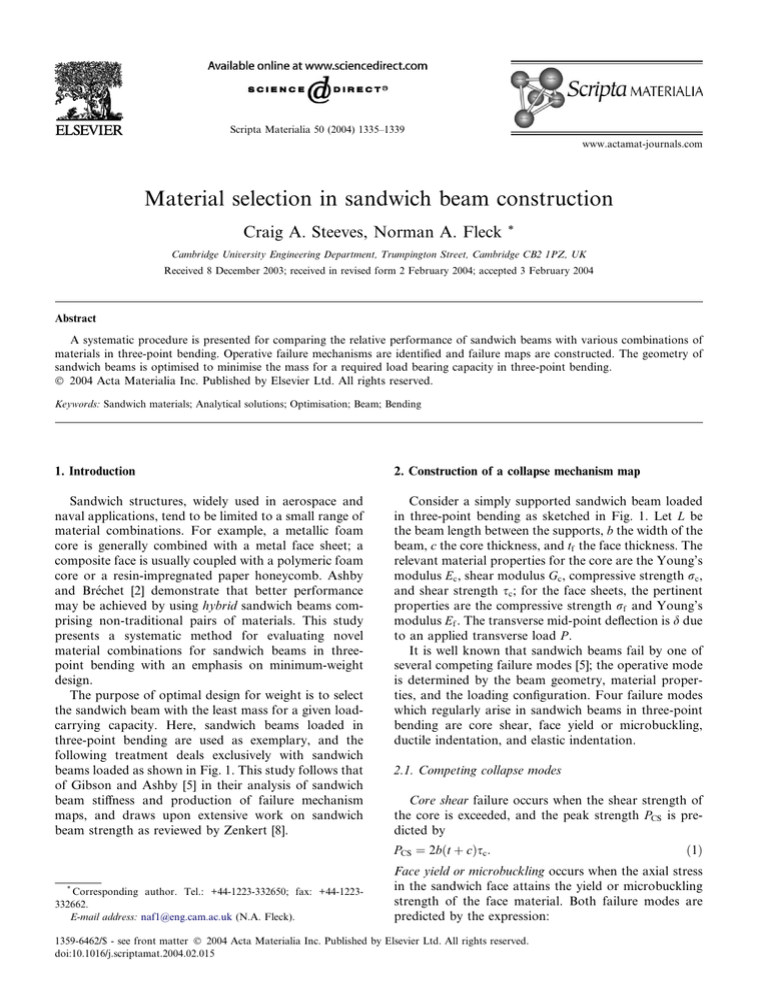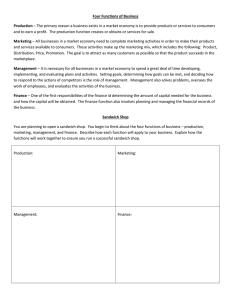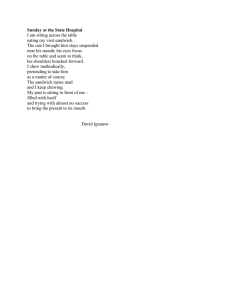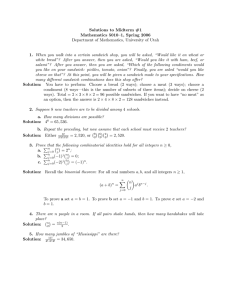
Scripta Materialia 50 (2004) 1335–1339
www.actamat-journals.com
Material selection in sandwich beam construction
Craig A. Steeves, Norman A. Fleck
*
Cambridge University Engineering Department, Trumpington Street, Cambridge CB2 1PZ, UK
Received 8 December 2003; received in revised form 2 February 2004; accepted 3 February 2004
Abstract
A systematic procedure is presented for comparing the relative performance of sandwich beams with various combinations of
materials in three-point bending. Operative failure mechanisms are identified and failure maps are constructed. The geometry of
sandwich beams is optimised to minimise the mass for a required load bearing capacity in three-point bending.
Ó 2004 Acta Materialia Inc. Published by Elsevier Ltd. All rights reserved.
Keywords: Sandwich materials; Analytical solutions; Optimisation; Beam; Bending
1. Introduction
2. Construction of a collapse mechanism map
Sandwich structures, widely used in aerospace and
naval applications, tend to be limited to a small range of
material combinations. For example, a metallic foam
core is generally combined with a metal face sheet; a
composite face is usually coupled with a polymeric foam
core or a resin-impregnated paper honeycomb. Ashby
and Brechet [2] demonstrate that better performance
may be achieved by using hybrid sandwich beams comprising non-traditional pairs of materials. This study
presents a systematic method for evaluating novel
material combinations for sandwich beams in threepoint bending with an emphasis on minimum-weight
design.
The purpose of optimal design for weight is to select
the sandwich beam with the least mass for a given loadcarrying capacity. Here, sandwich beams loaded in
three-point bending are used as exemplary, and the
following treatment deals exclusively with sandwich
beams loaded as shown in Fig. 1. This study follows that
of Gibson and Ashby [5] in their analysis of sandwich
beam stiffness and production of failure mechanism
maps, and draws upon extensive work on sandwich
beam strength as reviewed by Zenkert [8].
Consider a simply supported sandwich beam loaded
in three-point bending as sketched in Fig. 1. Let L be
the beam length between the supports, b the width of the
beam, c the core thickness, and tf the face thickness. The
relevant material properties for the core are the Young’s
modulus Ec , shear modulus Gc , compressive strength rc ,
and shear strength sc ; for the face sheets, the pertinent
properties are the compressive strength rf and Young’s
modulus Ef . The transverse mid-point deflection is d due
to an applied transverse load P .
It is well known that sandwich beams fail by one of
several competing failure modes [5]; the operative mode
is determined by the beam geometry, material properties, and the loading configuration. Four failure modes
which regularly arise in sandwich beams in three-point
bending are core shear, face yield or microbuckling,
ductile indentation, and elastic indentation.
2.1. Competing collapse modes
Core shear failure occurs when the shear strength of
the core is exceeded, and the peak strength PCS is predicted by
PCS ¼ 2bðt þ cÞsc :
*
Corresponding author. Tel.: +44-1223-332650; fax: +44-1223332662.
E-mail address: naf1@eng.cam.ac.uk (N.A. Fleck).
ð1Þ
Face yield or microbuckling occurs when the axial stress
in the sandwich face attains the yield or microbuckling
strength of the face material. Both failure modes are
predicted by the expression:
1359-6462/$ - see front matter Ó 2004 Acta Materialia Inc. Published by Elsevier Ltd. All rights reserved.
doi:10.1016/j.scriptamat.2004.02.015
1336
C.A. Steeves, N.A. Fleck / Scripta Materialia 50 (2004) 1335–1339
P,δ
PbM ¼ 4tðt þ 1Þc2
Ef, σf
tf
for ductile indentation as
Gc , Ec , σc , τc
c
1=2
PbID ¼ 2tcr
P/ 2
and for elastic indentation as
!1=3
2 2
p
E
r
tðt þ 1Þ1=3c4=3 :
PbIE ¼
3
P/ 2
L
Fig. 1. Geometry of sandwich beams.
PM ¼
ð10Þ
4bðt þ cÞrf
:
L
ð2Þ
Expressions (1) and (2) are provided in Zenkert [8] or
Allen [1]. Two modes of indentation are used here. The
first, described by Ashby et al. [3], is relevant to sandwich beams with metal foam cores and ductile faces. The
faces are assumed to form plastic hinges at the boundaries of the indentation region. The expression for peak
load in ductile indentation is
ð11Þ
ð12Þ
2.2. Collapse mechanism maps
ð3Þ
Gibson and Ashby [5] developed methods for the
graphic display of the collapse regimes for competing
failure mechanisms. Such mechanism maps are useful
tools for the optimisation of sandwich beams. The
optimisation strategy employed here is to find the
b
combinations of t and c to minimise the mass index M
for a given material combination and structural load
index Pb . The procedure is as follows:
An alternative indentation mode, modelled by Steeves
and Fleck [6], is relevant to sandwich beams for which
the indenting face sheet remains elastic while the core
yields plastically. The faces behave as a beam column
upon a non-linear foundation (provided by the core)
and the peak indentation load is
2
1=3
p ðt þ cÞEf r2c
PIE ¼ bt
:
ð4Þ
3L
(i) Calculate the weakest and therefore the active collapse mode. This gives the regimes of dominance
of each collapse mode in (c; t) space, and thereby
generates the collapse mechanism map.
b for any as(ii) Seek the value of (c; t) that minimises M
b
sumed value of P .
(iii) Repeat step (ii) for other values of Pb , in order to
construct the minimum mass trajectory.
This failure mode will be referred to as elastic indentation.
It is convenient to express the geometrical and
material parameters in the non-dimensional form:
The trajectory of optimal design usually lies along the
boundary between collapse mechanisms, but can also
occur within the face yield/microbuckling domain, or
within the elastic indentation domain. Fig. 2 is an
PID ¼ 2btðrc rf Þ
t ¼ t=c;
1=2
:
c ¼ c=L;
s ¼ sc =rf ;
¼ rc =rf ;
r
E ¼ Ef =rf ;
and
¼ qc =qf :
q
ð5Þ
Now define a load index Pb as
P
Pb ¼
:
bLrf
ð6Þ
The mass M of a sandwich beam is given by
M ¼ bLð2tqf þ cqc Þ
ð7Þ
b is
and the non-dimensional mass index M
b ¼ M ¼ cð2t þ q
Þ;
M
bL2 qf
ð8Þ
where the non-dimensional parameters from (5) are
substituted into (7) and (8).
Similarly, the failure loads (1)–(4) can be nondimensionalised for core shear failure as
PbCS ¼ 2sðt þ 1Þc
for microbuckling or face yield as
ð9Þ
Fig. 2. Failure mechanism map for GFRP face sheets and medium
b and structural
density H100 foam core. Contours of mass index 102 M
load index 104 Pb are labelled with their numerical values. The solid
bold line denotes the boundary between the indentation and core shear
regimes, and the arrows follow the minimum weight trajectory.
C.A. Steeves, N.A. Fleck / Scripta Materialia 50 (2004) 1335–1339
1337
Table 1
Material properties of representative constituents of sandwich beams
Material
Density (kg/m3 )
Tensile/compressive strength (MPa)
CFRP faces
GFRP faces
Medium strength steel faces
Steel square honeycomb core
PVC foam core
1600
1770
8000
800
100
650
350
400
20
1.45
Shear strength (MPa)
Young’s modulus (GPa)
65
30
210
20
1.66
GFRP ¼ glass fibre reinforced plastic; CFRP ¼ carbon fibre reinforced plastic.
example of a failure mechanism map for a Hexcel Fibredux woven GFRP face and Divinycell H100 PVC
foam core. (Properties for all materials are contained in
Table 1.) Mass is minimised in (c; t) space along the
trajectory where the gradient of the mass index is locally
parallel to the gradient of the load index, or on a
boundary between two regimes. In this example, only
the failure modes of elastic indentation and core shear
are active. Contours of structural load index Pbmin and
b are superimposed on the map, and a
mass index M
trajectory of minimum weight design is along the path
b are parallel to the contours of
where the contours of M
b
P min . The minimum weight design trajectory begins in
the elastic indentation region for small values of c and
switches to the boundary between elastic indentation
and core shear at c 0:22.
A similar map for a sandwich beam with a steel face
and a steel core comprising a square honeycomb is
displayed in Fig. 3. Here, the three operative failure
modes are face yield, ductile indentation, and core shear.
The trajectory of minimum weight design starts in the
face yield region, and passes along the face yield––ductile indentation boundary and then along the core
shear––ductile indentation boundary as Pb increases.
2.3. Minimum weight design as a function of structural
load index
Expressions for minimum weight design within each
failure regime and along the regime boundaries are now
obtained. In the microbuckling region, we have
b min ¼ ð
Þ Pb Þ1=2 ;
M
qð2 q
ð13Þ
with the optimal value of t given by
t ¼
q
:
Þ
2ð1 q
ð14Þ
Similarly, within the elastic indentation region, the
b min is
minimum mass index M
!1=4
ð2 q
Þ3
b min ¼ 4 q
M
Pb 3=4 ;
ð15Þ
2 E
9p2 r
with t given by
t ¼
3
q
:
2ð1 2
qÞ
ð16Þ
For the boundary between elastic indentation and face
b min is
yield/microbuckling, the minimum mass index M
1=2
Þ 3 1=2 b
E
p
qr
2ð2 q
b
M min ¼
P:
ð17Þ
þ
8
3
p
r
E
On the boundary between elastic indentation and core
shear, it is found that
!1=3
Pb
6
s
q
b min ¼
Þ Pb 2=3 þ
M
:
ð18Þ
ð2 q
2
2
2s
E
pr
Similarly, on the elastic indentation–ductile indentation
boundary, we have
!
24
q
q
2
b min ¼
M
Pb
:
ð19Þ
2
r1=2
1=2 E
p2 r
The remaining expressions are, for the face yield/microbuckling–core shear boundary:
Fig. 3. Failure mechanism map for steel face sheets and square steel
b and structural load index
tube core. Contours of mass index 102 M
103 Pb are labelled with their numerical values. Solid bold lines indicate
the boundaries between failure mechanisms regimes, and arrows follow
the minimum weight trajectory.
b s
b min ¼ P q
Þ
þ ð2 q
M
2s 2
ð20Þ
for the boundary between face yield/microbuckling and
ductile indentation:
1338
b min
M
C.A. Steeves, N.A. Fleck / Scripta Materialia 50 (2004) 1335–1339
Þ
Pb ð2 q
q
1=2 þ
r
¼
r
1=2
2
q
!
ð21Þ
and for the boundary between core shear and ductile
indentation:
!
b q
P
2
q
b min ¼
M
ð22Þ
þ 1=2 :
2 s
r
To assess the performance of any combination of
materials, the explicit relationship between the strucb min is
tural load index Pb and the minimum mass index M
b involve
required. The definition (6) for Pb and (8) for M
the strength rf and density qf of the face sheets. This
makes it difficult to explore the effect of the choice of
face sheet upon sandwich beam performance. To allow
for a direct comparison of the performance of various
material combinations, the normalised values Pb N of Pb
b N of M
b are introduced, by using the strength rs
and M
and density qs of a medium strength steel (as listed in
Table 1):
rf
Pb N Pb
ð23Þ
rs
and
b:
b N qf M
M
qs
ð24Þ
This procedure minimises mass for a given strength
requirement. Other optimisations could be performed;
for example, mass could be minimised for a given
structural stiffness. Performance criteria, such as corrosion resistance, fracture toughness, or fatigue resistance,
can be treated similarly.
The minimum weight designs for selected sandwich
beams are presented in Fig. 4, upon making use of the
material property data listed in Table 1. These comprise
the three face sheet materials carbon fibre reinforced
plastic (CFRP), glass fibre reinforced plastic (GFRP)
and steel plate; two core materials are addressed: Divinycell H100 PVC foam and a steel core composed of a
square honeycomb (see [4]). (The properties of steel
lattice core are very close to those of the H100 PVC
foam core, for the case of a pyramidal core of density
100 kg/m3 ; see [7].) To select the material combination
for minimum weight design, one chooses the materials
b min for any selected value of Pb . It is
which minimise M
clear from Fig. 4 that, at low values of Pb , the optimal
choice of materials is CFRP faces with a PVC foam
core. For higher values of Pb , CFRP faces with a steel
square honeycomb core is preferred. Here, we have used
only five exemplary materials; a full optimisation would
involve a database including a much larger selection of
materials. Note also that not all combinations of
materials are compatible (for manufacturing or other
reasons) and that some engineering judgement is required to assess the viability of material combinations.
N
b min
Fig. 4. Variation of minimum mass index M
with structural load
index Pb N for a variety of material combinations. Minimum mass is
b min for a
found by choosing the material system with the minimum M
given Pb . EI ¼ elastic indentation; MB/FY ¼ microbuckling/face yield;
CS ¼ core shear; DI ¼ ductile indentation.
3. Concluding remarks
The above analysis demonstrates a systematic method for choosing the best materials for achieving minimum mass design of a sandwich beam under given
loading conditions. The set of materials considered is
intended to be illustrative but not exhaustive. It does,
however, illustrate the potential for using non-traditional material combinations in sandwich construction:
while a Ôtraditional’ combination of carbon-fibre composite face sheet and polymer foam core is optimal for
low structural load indices, at higher structural load
indices the hybrid carbon-fibre composite––steel square
honeycomb core beam is optimal. Recently developed
lattice cores [7] have similar or superior properties to
polymeric foam cores, and opportunities remain to develop new core topologies and new material combinations to maximise sandwich beam performance over the
entire range of structural load index.
References
[1] Allen HG. Analysis and design of structural sandwich panels.
Oxford: Pergamon Press; 1969.
[2] Ashby MF, Brechet YJM. Designing hybrid materials. Acta Mater
2003;51:5801–21.
[3] Ashby MF, Evans AG, Fleck NA, Gibson LJ, Hutchinson JW,
Wadley HNG. Metal foams: a design guide. Butterworth Heinemann; 2000.
[4] Cote F, Deshpande VS, Fleck NA, Evans AG. The out-of-plane
compressive behaviour of metallic honeycombs. J Mater Sci Eng A,
2004, in press.
[5] Gibson LJ, Ashby MF. Cellular solids. Cambridge: Cambridge
University Press; 1988.
[6] Steeves CA, Fleck NA. Collapse mechanisms of sandwich beams
with composite faces and a foam core, loaded in three-point
C.A. Steeves, N.A. Fleck / Scripta Materialia 50 (2004) 1335–1339
bending. Part I: analytical models and minimum weight design. Int
J Mech Sci, submitted for publication.
[7] Wadley HNG, Fleck NA, Evans AG. Fabrication and
structural performance of periodic cellular metal sand-
1339
wich structures. Compos Sci Technol 2003;63(16):2331–
43.
[8] Zenkert D. An introduction to sandwich construction. Sheffield,
UK: Engineering Materials Advisory Service; 1995.




